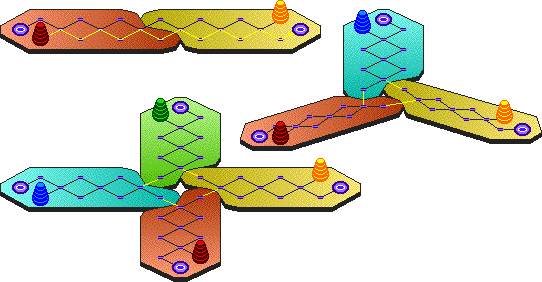Each player has a 14-points track in front of him and places his stack on the leftmost point.

The track follows the player's side of the segments, as indicated on the 2-player board, so player's interact only on the centerpoints. The light lines near the center of the 3- and 4-player layout are not actually part of the board, but indicate how the tracks switch from one segment to the next.
Object
The object is to move one's stack along the track to the other side, disc by disc according to the throw of two dice, and come in first in the process.
Rules
- One player moves first, after which player's take turns clockwise.
On his turn a player throws two dice.
- If the throw is unequal, the player moves his discs accordingly.
- If it is a double, the player must add the reverse side of the dice and move his discs accordingly.
- A move may be forwards or backwards as the player pleases, counting onwards in the opposite direction if it passes over the begin- or endpoint of the track.
A player may not pass (part of) his move, but a disc may land on the point it started from if it passes over the begin- or endpoint of the track. - A disc may never land on a smaller disc, nor may it move over an opponent's smaller disc.
- If a disc lands on a disc of equal size it takes its place, while the 'captured' disc returns to its starting point, where it is inserted according to size.
- A disc may freely land on any larger disc, which then, for the time being, is blocked.
Every number of eyes must be moved seperately. If a player for instance throws 3-5 on his first move and uses them to move the top disc 5 steps and the second disc 3, and if on his next turn he again throws 3-5, then he won't be able to move the third disc 8 steps, because the 3 and the 5 must be moved seperately, and both points are blocked by a smaller disc.
Entering
Since no disc may land on a smaller one, the last one out must be the first one in.
In the initial position the 'next disc to enter' is the largest one, for every player. Once the largest one has been moved to the endpoint, the second largest one is the 'next disc to enter'. Thus, in any stage of the game, every player has exactly one 'next disc to enter'.
- All moves follow exact count, except the 'next disc to enter': once it has reached the endpoint, the remainder of that part of the move may be discarded.
Every player is entitled to the same number of turns as the first player who enters all his discs, so after this has happened, one or more players may be entitled to an 'afterthrow'. Players may finish ex aequo that way.
The doubling die
If played for stakes, a doubling die may be employed much the same way as in Backgammon. If in a multi player game, a player leaves on a double, his discs remain where they are as if he were still in the game.
How I invented ... Trackgammon
Trackgammon © MindSports
